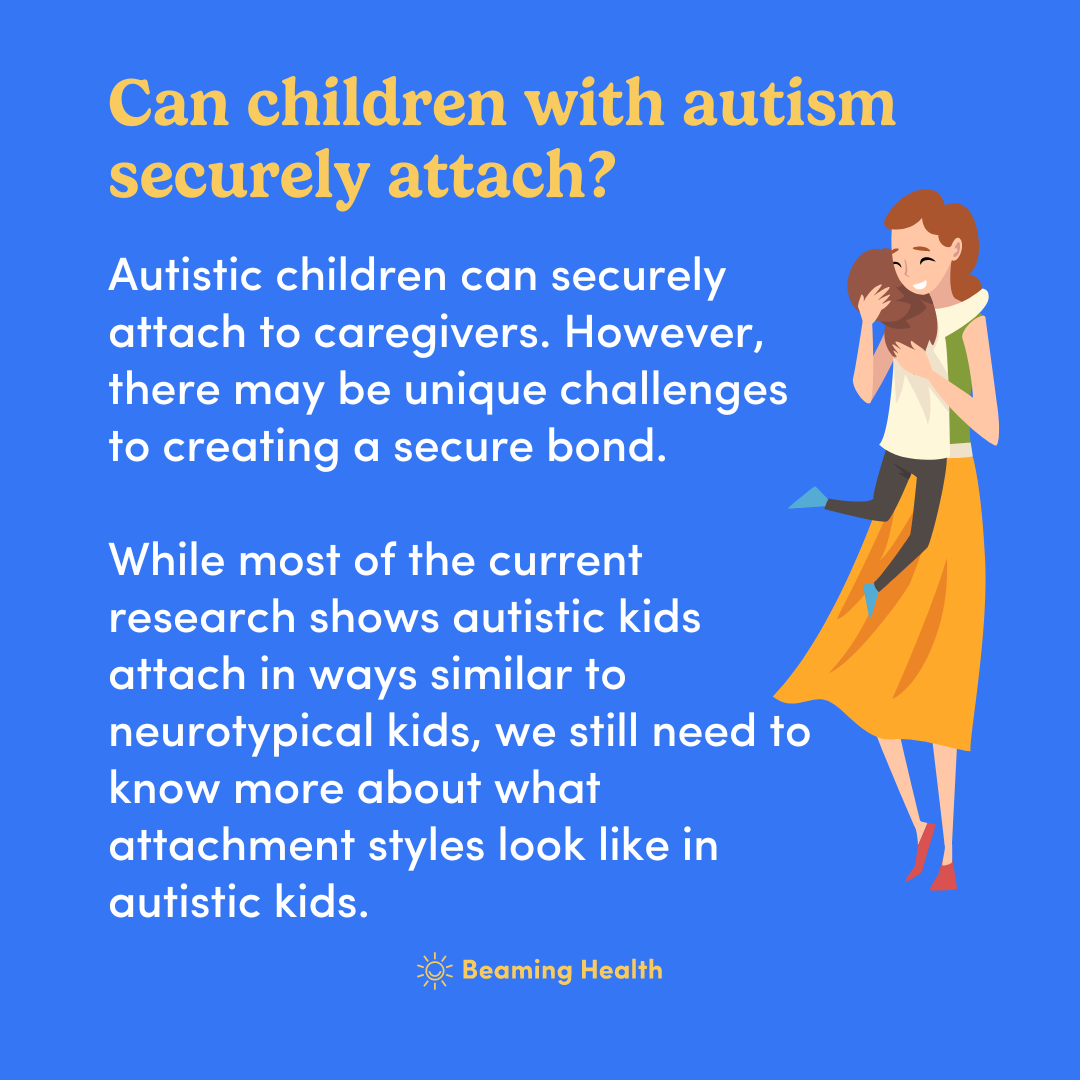Autism and attachment: Can autistic children securely attach?
Updated: August 4, 2023 · 4 Minute Read

Written by:
Jeryn Cambrah
Highlights
- Autistic children can securely bond with caregivers though there are unique challenges to creating a secure attachment.
- Research shows that clinicians have difficulty telling attachment disorders and autism apart because the behaviors associated with them are so similar.
Autism and attachment: Can autistic kids securely attach to their parents/caregivers?
Yes! All humans naturally seek attachment with their caregivers, and autistic children are no different. We all want to be loved, understood, and cared for.
Children with autism can and do securely attach to their parents/caregivers and experience unique bonds with individual caregivers. They can show differentiation of caregivers or preference for one particular caregiver, just as neurotypical children do.1 Research shows that autistic kids respond in similar ways to neurotypical kids, seeking out their caregiver to know it’s safe to explore an environment, and being upset and seeking out their caregiver when they leave the room.1

While more research is needed on autism and attachment, there’s nothing to suggest the process of attachment is fundamentally different for an autistic child. As kids get older, they’re able to recognize and articulate complex emotions like love, disgust, disappointment, and more. But when they’re small, the primary way they bond with parents is through the responsiveness of the parent (meeting needs, play, attention, etc.). This bond is also emotional, not just needs-based — the child wants the parent not just to be taken care of, but to be loved and understood as well.
Is it difficult for autistic children to securely attach?
It’s true that autistic children are less likely to securely attach to caregivers and parents than their neurotypical peers. One study suggests autistic children may form attachments later than neurotypical peers, and have alternate ways of expressing attachment security.2 There are many factors and challenges that might contribute to this, including parenting style, ability to communicate, and difficulty expressing or understanding emotions.

Is there a link between attachment disorders and autism?
Some of the behaviors associated with autism are also associated with attachment disorders. In one study, about 67% of kids on the spectrum also met the criteria for an attachment disorder.3
In fact, clinicians may misdiagnose children because the signs of neurodevelopmental disabilities (like autism and ADHD) and the behaviors of attachment disorders are so similar.4 Children with attachment disorders often have “autistic traits” such as “atypical” hand movements (flapping, etc.).
What are attachment disorders?
Attachment disorders are a collection of conditions that children can develop when they cannot securely attach to their caregivers, usually due to neglect, abuse, or lack of opportunities to bond.3 Some parents are separated from their child after birth (like the child being placed in the NICU) or due to family issues, foster care, etc. These periods of separation interrupt the bonding process and can contribute to attachment issues.
Is it autism or an attachment disorder?
It’s hard to tell. Attachment disorders can co-occur along with autism and other disabilities, too. According to one professional, signs of autism would remain pretty consistent across all environments, whereas signs of an attachment disorder would vary depending on where the child is and who they’re with.3 Researchers are still trying to figure out the best way to distinguish between autism and signs of insecure attachment in children.
Conclusion
You and your child can form a secure attachment! There are many benefits to your child’s life and your relationship with them when you do. Learn more about attachment styles in our Learning Center. Check out our expert-reviewed guide for tips on how to securely attach with your kiddo on the spectrum.
Get our best articles delivered to your inbox each month.
We respect your privacy.
Article References
- Rozga A, Hesse E, Main M, Duschinsky R, Beckwith L, Sigman M. A short-term longitudinal study of correlates and sequelae of attachment security in autism. Attachment & Human Development. 2017;20(2):160-180. doi:10.1080/14616734.2017.1383489
- Siller M, Swanson M, Gerber A, Hutman T, Sigman M. A Parent-Mediated Intervention That Targets Responsive Parental Behaviors Increases Attachment Behaviors in Children with ASD: Results from a Randomized Clinical Trial. Journal of Autism and Developmental Disorders. 2014;44(7):1720-1732. doi:https://doi.org/10.1007/s10803-014-2049-2
- Coughlan B, van IJzendoorn MH, Woolgar M, Weisblatt EJL, Duschinsky R. Differentiating "Attachment Difficulties" From Autism Spectrum Disorders and Attention Deficit Hyperactivity Disorder: Qualitative Interviews With Experienced Health Care Professionals. Front Psychol. 2022;12:780128. Published 2022 Feb 7. doi:10.3389/fpsyg.2021.780128
- McKenzie R, Dallos R. Autism and attachment difficulties: Overlap of symptoms, implications and innovative solutions. Clin Child Psychol Psychiatry. 2017;22(4):632-648. doi:10.1177/1359104517707323












